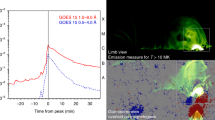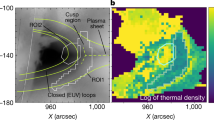Abstract
We solve the energy equation for the high-temperature (coronal) component of flare plasma for two models of energy input: (i) direct collisional heating by a beam of suprathermal electrons, and (ii) ohmic heating by the beam-neutralizing reverse current. We discuss the regimes where each case is applicable, and solve for the differential emission measure distribution of the coronal plasma in each case. ‘Scaling laws’ between loop temperatures and injected electron fluxes are derived for both models; these are testable observationally through coordinated soft X-ray and hard X-ray observations, thus providing a method of discriminating between the two cases. We also readdress the question of the energetic importance of a return current which is below the instability threshold for generation of ion-acoustic plasma turbulence. We find that unless the ambient coronal density is very low (≲ 109 cm −3), collisional heating will always dominate there, in agreement with the findings of previous authors. However, in the chromosphere/corona transition region, the relatively low temperature and correspondingly high plasma resistivity imply that reverse current ohmic heating can predominate the flare energetics, by up to an order of magnitude.
Similar content being viewed by others
References
Brown, J. C.: 1971, Solar Phys. 18, 489.
Brown, J. C.: 1972, Solar Phys. 26, 441.
Brown, J. C. and Bingham, R.: 1984, Astron. Astrophys. 131, L11.
Brown, J. C. and Hayward, J.: 1982, Solar Phys. 80, 129.
Canfield, R. C., et al.: 1985, in Solar Flares-Proceedings of the SMM Workshop, Chapter 3.
Craig, I. J. D. and Brown, J. C: 1976, Astron. Astrophys. 59, 239.
Culhane, J. L. and Acton, L. W.: 1970, Monthly Notices Roy. Astron. Soc. 151,.141.
Emslie, A. G.: 1980, Astrophys. J. 235, 1055.
Emslie, A. G.: 1981, Astrophys. J. 249, 817.
Emslie, A. G. and Smith, D. F.: 1984, Astrophys. J. 279, 882.
Knight, J. W. and Sturrock, P. A.: 1977, Astrophys. J. 218, 306.
MacNeice, P., McWhirter, R. W. P., Spicer, D. S., and Burgess, A.: 1984, Solar Phys. 90, 357.
Nagai, F. and Emslie, A. G.: 1984, Astrophys. J. 279, 896.
Pottasch, S. R.: 1964, Space Sci. Rev. 3, 816.
Spitzer, L. W.: 1962, Physics of Fully Ionized Gases, 2nd ed., Interscience, New York.
Author information
Authors and Affiliations
Additional information
Presidential Young Investigator.
Rights and permissions
About this article
Cite this article
Emslie, A.G. The structure of high-temperature solar flare plasma in non-thermal flare models. Sol Phys 98, 281–291 (1985). https://doi.org/10.1007/BF00152461
Received:
Revised:
Issue Date:
DOI: https://doi.org/10.1007/BF00152461




